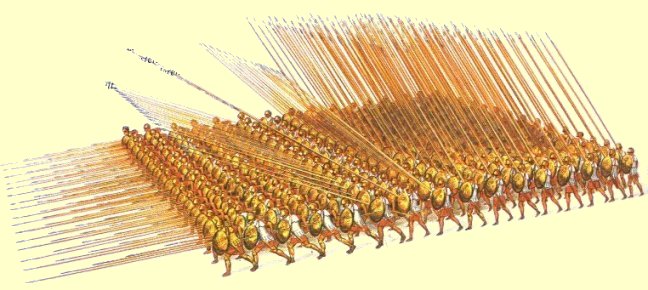Phalanx
A phalanx is a rectangular array of infantry consisting of spear or pikemen in close order so their spears can be used to keep the enemy at bay. The formation was basically a wall of spears and shields that was drilled to stay in formation. The Greeks were the first to use the phalanx in warfare. It consisted of heavily armored hoplites with 6 foot spears, used for stabbing not throwing. They were formed in ranks six deep with overlapping wooden shields. This method of warfare was very direct, the two sides charged each other with the victor being the phalanx that wasn't broken. The first phalanxes appear on Sumerian inscriptions, and they dominate the battlefield for centuries, reaching their culmination in the Macedonian phalanx. This was an invention of Philip II of Macedon the father of Alexander the Great. His phalangites were professional soldiers, and were among the first troops ever to be drilled, thereby allowing them to execute complex maneuvers well beyond the reach of most other armies. The typical Macedonian phalanx would be 16 rows deep and Philip armed them with a sarissa a nearly 4 meter long double-pointed pike.

The sarissa was carried in two pieces and assembled before the battle, it had to be wielded with two hands. Unlike the earlier hoplites, phalangites were unarmored except possibly those of the first row, and carried only tiny shields. No enemies were expected to get close enough for them to need any, plus their wall of spears blocked arrows rather effectively. The sarissa's of the first five rows all projected beyond the front of the formation. As a secondary weapon the phalangites carried a small dagger to finish of anyone still alive as they walked over them. This wall of spears was virtually impossible to penetrate and was able to provide the Macedonians a solid base used to hold the enemy in place while their light cavalry broke through the enemy ranks. This type of phalanx was effectively wielded by Alexander the Great to conquer Greece and the Middle East. Although phalanxes are generally good on forward defense, they have difficulty advancing and are weak on the flanks. They were later largely replaced by the much more mobile Roman legions who defeated them on several occasions, most famous being the Battle of Pydna. After this, phalanxes became more or less obsolete although phalanxes of pikemen were later employed against mounted knights with considerable success.